Panasonic Lumix TZ80 / ZS60 review
-
-
Written by Ken McMahon
Quality
Panasonic Lumix TZ80 / ZS60 JPEG quality results
To test real-life performance, I shot this scene with the Panasonic Lumix TZ80 / ZS60 using its best quality JPEG setting and at its base 80 ISO sensitivity setting. The TZ80 / ZS60 was mounted on a tripod and image stabilisation was disabled, the sensitivity was manually set to 80 ISO and Aperture priority mode was selected for the exposure. I set the Aperture to f3.3 which I’d previously determined produced best results and the Lumix TZ80 / ZS60 chose a shutter speed of 1/1000.
The TZ80 / ZS60 has optional diffraction compensation which attempts to correct for the reduction in image quality caused by light diffraction at small aperture sizes. Diffraction compensation is turned off by default and so that’s where I left it for these quality tests.
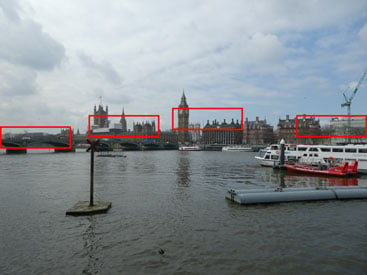
Let’s take a look at the crops. The first table below shows the Lumix TZ80 / ZS60 at its maximum 24mm equivalent wide angle setting with, as I’ve said, the aperture set to f3.3. The crops are taken from across the frame with the first and last from close to the left and right edges with the crops two and three closer to the middle of the frame. The TZ80 / Z60 doesn’t get off to a great start, the first crop is quite soft and even a little clumpy. There’s not a lot of detail to be seen either in the bridge and traffic in the foreground or the buildings behind.
The second and third crops are from close to the middle of the frame and there is more detail here particularly third one which is closest to the middle. You can make out more detail in the buildings in these crops and there’s a good level of detail in the Westminster tower clock, though you can’t differentiate the minute markings.
The final crop from the right edge of the frame is very similar to the first one, soft and lacking in detail, though there’s not a lot of distortion and no colour fringing. On the basis of this first set of crops I’d say it’s an ok performance from the Lumix TZ80 / ZS60 and quite respectable for a compact sensor, but I’m not yet convinced that Panasonic’s decision to up the pixel count to 18 Megapixels from the TZ70 / ZS50’s 12 Megapixels is a resounding success.
Scroll down the page to see more quality results from the Lumix TZ100 / ZS100 at a range of longer focal lengths, to find out how it performs at higher sensitivities head for my Panasonic Lumix TZ80 / ZS60 noise results, skip to my Panasonic Lumix TZ80 / ZS60 sample images, or head straight to my verdict.

Above: Panasonic Lumix TZ80 / ZS60 at 4.3mm (23.3mm equivalent) f3.3 80 ISO

Above: Panasonic Lumix TZ80 / ZS60 at 4.3mm (23.3mm equivalent) f3.3 80 ISO

Above: Panasonic Lumix TZ80 / ZS60 at 4.3mm (23.3mm equivalent) f3.3 80 ISO

Above: Panasonic Lumix TZ80 / ZS60 at 4.3mm (23.3mm equivalent) f3.3 80 ISO
Panasonic Lumix TZ80 / ZS60 quality at 50mm equivalent
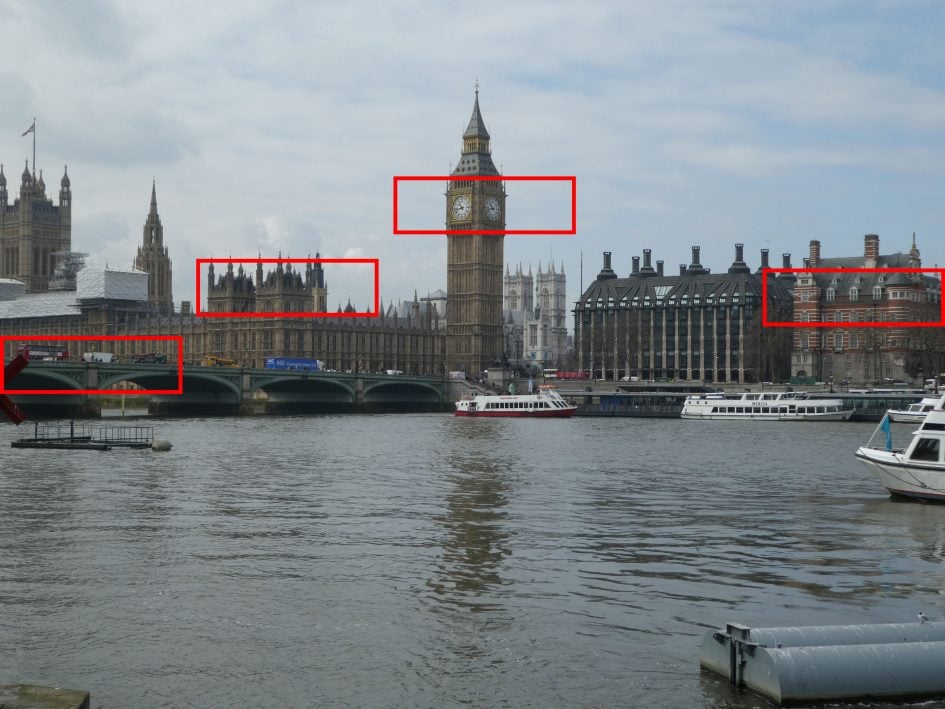
The image above was taken with the Lumix TZ80 / ZS60 at 50mm equivalent. As the lens is zoomed in on the TZ80 / ZS60, the maximum aperture closes. At each focal length tested I set the aperture to the maximum available – in this case f4.1. As before the camera was mounted on a tripod and stabilisation disabled. The crops are taken from the areas marked in red.
At 50mm equivalent the detail is a little more clearly visible, but of course it’s larger. The main difference between this set of crops and the previous ones is that these are more consistent. the last crop is a little less distinct than the others, but generally there’s not much to distinguish the edge crops from the middle ones. The other thing that they all have in common is visible noise and, in the main, that’s what’s getting in the way of more detail being resolved.
Scroll down to see how it performs at longer focal lengths. To find out how it performs at higher sensitivities head for my Panasonic Lumix TZ80 / ZS60 noise results, skip to my Panasonic Lumix TZ80 / ZS60 sample images, or head straight to my verdict.

Above: Panasonic Lumix TZ80 / ZS60 at 9mm (50mm equivalent) f4.1 80 ISO

Above: Panasonic Lumix TZ80 / ZS60 at 9mm (50mm equivalent) f4.1 80 ISO

Above: Panasonic Lumix TZ80 / ZS60 at 9mm (50mm equivalent) f4.1 80 ISO

Above: Panasonic Lumix TZ80 / ZS60 at 9mm (50mm equivalent) f4.1 80 ISO
Panasonic Lumix TZ80 / ZS60 quality at 373mm equivalent
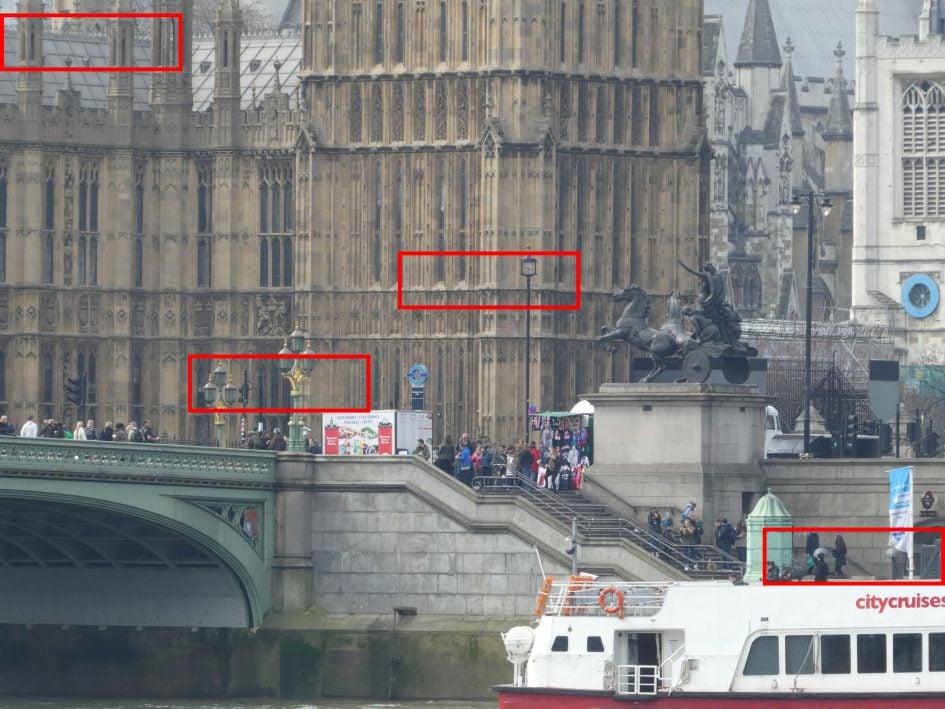
For this next set of crops I zoomed The TZ100 / ZS100 in to 373mm equivalent – around the mid-point of its zoom range. In this set it’s the first crop from close to the left edge of the frame, which looks softer and doesn’t have the same level of detail as the others at this focal length. Moving towards the middle of the frame, the second crop is likewise a little soft, though it is an improvement. The remaining two are much the same – a little softer and lacking in detail than would ideally be the case, but consistent at least.
Scroll down to see how it performs at longer focal lengths. To find out how it performs at higher sensitivities head for my Panasonic Lumix TZ80 / ZS60 noise results, skip to my Panasonic Lumix TZ80 / ZS60 sample images, or head straight to my verdict.

Above: Panasonic Lumix TZ80 / ZS60 at 66.8mm (373mm equivalent) f6 80 ISO

Above: Panasonic Lumix TZ80 / ZS60 at 66.8mm (373mm equivalent) f6 80 ISO

Above: Panasonic Lumix TZ80 / ZS60 at 66.8mm (373mm equivalent) f6 80 ISO

Above: Panasonic Lumix TZ80 / ZS60 at 66.8mm (373mm equivalent) f6 80 ISO
Panasonic Lumix TZ80 / ZS60 quality at 720mm equivalent
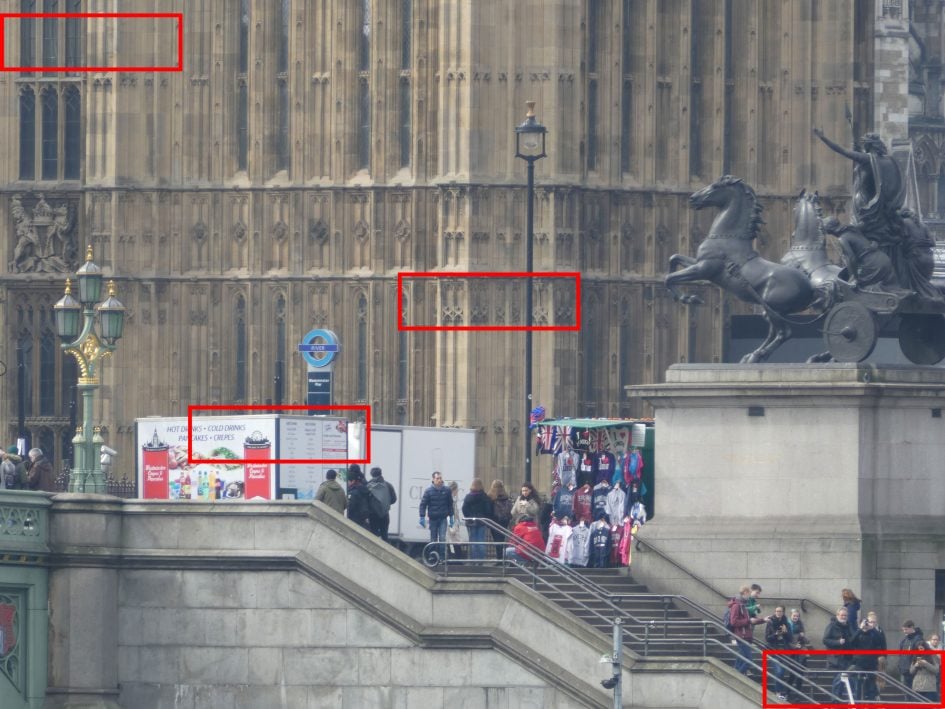
For this final comparison, I zoomed the TZ80 / ZS60 in to its maximum 720mm equivalent focal length. On one quality measure – consistency across the frame – it’s hard to fault the TZ80 / ZS60. With the exception of the final crop at this maximum focal length, they all look very similar, which is to say a little soft and a little lacking in fine detail apparently due to noise.
The last crop shows a little bit of colour fringing, but it also looks a lot noisier, most likely becasue the area is in shadow. There’s no clean edge on the hand rails which look furry as do the steps behind. So what’s the verdict on the quality delivered by the new 18 Megapixel sensor in the Lumix TZ80 / ZS60 in comination with the 24-720mm lens? In my view, not bad, but not great either. At 80 ISO you can expect photos with a good level of detail across the frame at all focal lengths, but at 100 percent viewing size they’re not pin sharp and, even at this base ISO sensitivity, there’s noise around. It’ll be interesting to see how the Lumiz TZ80 / ZS60 performs at higher sensitivities.
To find out how it performs at higher sensitivities head for my Panasonic Lumix TZ80 / ZS60 noise results, skip to my Panasonic Lumix TZ80 / ZS60 sample images, or head straight to my verdict.

Above: Panasonic Lumix TZ80 / ZS60 at 129mm (720mm equivalent) f6.4 80 ISO

Above: Panasonic Lumix TZ80 / ZS60 at 129mm (720mm equivalent) f6.4 80 ISO

Above: Panasonic Lumix TZ80 / ZS60 at 129mm (720mm equivalent) f6.4 80 ISO

Above: Panasonic Lumix TZ80 / ZS60 at 129mm (720mm equivalent) f6.4 80 ISO
Panasonic Lumix TZ80 / ZS60 JPEG noise results
To examine noise levels under real-life conditions, I shot this scene with the Panasonic Lumix TZ80 / ZS60 at each of its ISO settings using the highest quality JPEG setting. The TZ80 / ZS60 was mounted on a tripod and stabilisation was disabled.
The camera was set to its maximum wide angle 24mm equivalent view. The ISO sensitivity was manually set to the lowest available setting and Aperture priority mode was selected for the exposure.
I’d previously determined that f3.3 produced the best results from the TZ80 / ZS60 and with the aperture set to f3.3 and the sensitivity set to 80 ISO, the the TZ80 / ZS60 metered an exposure of 0.8s.
Just to note the sensitivity range of the Lumix TZ80 / ZS60 is 80 to 3200 ISO, but it can be extended to 6400 ISO.
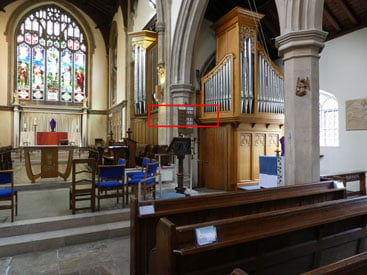
The 80 ISO crop from the Lumix TZ80 ZS60 looks pretty good. Areas of flat colour with no detail look like they should, you have to look very carefully – in the wood panels of the hymn board and on the far left of the crop – to see any evidence of noise textures. If you look at the labels and numbers on the hymn board, though, you can see noise texture interfering a little with the detail – something that was very noticeable in some of the crops from my outdoor test.
The 100 ISO crop also looks good, there’s a tiny bit more noise, but you have to look carefully at these 100 percent crops to spot it. I’d happily use the 100 ISO and 80 ISO settings interchangeably. And at 200 ISO the Lumix TZ80 / ZS60’s noise performance is holding up well, a tiny bit noisier than the 100 ISO crop, but still very acceptable.
At 400 ISO the Lumix TZ80 /ZS60 is beginning to show the strain. Noise textures are now clearly visible pretty much everywhere and you don’t have to look too hard to spot them. You’d certainly notice this degradation in quality on a big print, but at smaller sizes it’s not worth worrying about. At 1600 ISO the noise is sufficiently severe to affect the quality at smaller viewing sizes and this is about the upper limit of acceptable quality. 3200 and the extended 6400 are good to have for low-light emergencies where getting the shot matters more than the quality.

Above: Panasonic Lumix TZ80 / ZS60 JPEG 80 ISO

Above: Panasonic Lumix TZ80 / ZS60 JPEG 100 ISO

Above: Panasonic Lumix TZ80 / ZS60 JPEG 200 ISO

Above: Panasonic Lumix TZ80 / ZS60 JPEG 400 ISO

Above: Panasonic Lumix TZ80 / ZS60 JPEG 800 ISO

Above: Panasonic Lumix TZ80 / ZS60 JPEG 1600 ISO

Above: Panasonic Lumix TZ80 / ZS60 JPEG 3200 ISO

Above: Panasonic Lumix TZ80 / ZS60 JPEG 6400 ISO




